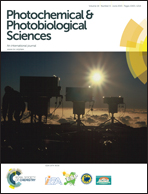Non-radiative deactivation in phenol–pyridine complex: theoretical study†
Abstract
Minimum energy structures of the ground and lowest excited states of the phenol (PhOH)–pyridine (Py) hydrogen-bonded complex in the gas phase were determined by ab initio calculations. Photophysical and photochemical features of the complex under Cs symmetry (planar (Pl) and perpendicular (Pe) conformers) and without any symmetry constraints (unconstrained (Un) conformer) were studied with respect to nonradiative decay processes to the ground state. The mechanism involves internal conversion (IC) and intersystem crossing (ISC) along the O–H bond elongation coordinate, where a coupled electron/proton-transfer reaction plays a decisive role in the photophysics of this complex. For the Pl conformer, nonradiative decay proceeds from a locally excited 1ππ*(LE) minimum over a conical intersection barrier (0.12 eV) to a charge-transfer (CT) minimum, which corresponds to a hydrogen-bonded PhO˙⋯HPy˙ biradical. Near this second minimum, a barrierless conical intersection 1A′(ππ*(CT))–S0 funnels the electron population from the CT to the ground S0 state, completing the nonradiative deactivation. Calculations performed for the Pe and Un conformers confirmed that the same radiationless mechanism proceeds with no 1ππ*(LE)/1ππ*(CT) conical intersection near the Franck–Condon region. Furthermore, the population of the lowest triplet states via ISC and their contribution to the photophysics of PhOH–Py complex have been discussed. These findings appear to suggest that there is no single dominant path, but rather many distinct paths involving different quenching mechanisms.


 Please wait while we load your content...
Please wait while we load your content...